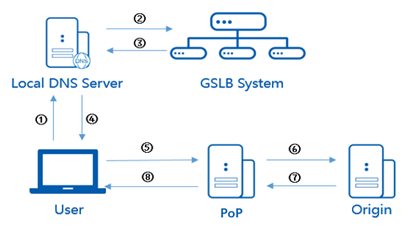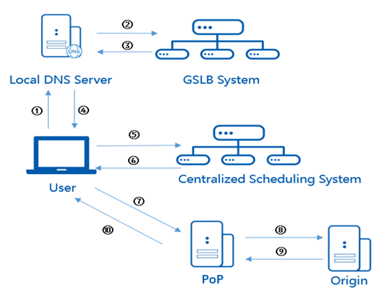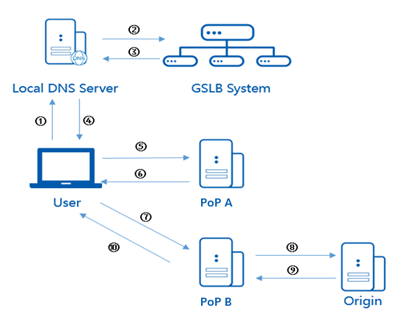NGB Scheduling
Last update:2022-04-08 15:00:00
1 Feature Intro
1.1 Brief Introduction
NGB stands for Next Generation Balancer, and NGB Scheduling is used to serve end-users from the optimal PoP on CDN network. Based on DNS protocol and HTTP protocol, it routes content requests from an end-user to a nearby PoP that is best able to serve the content, bringing users faster and more satisfying web experiences.
1.2 Applicable Product Lines
- Content Acceleration
- Dynamic Web Acceleration
- Download Acceleration
- Media Acceleration
- Media Acceleration Live Broadcast
2 Feature Detail
NGB Scheduling generally includes 3 types: DNS Scheduling, Centralized Scheduling and Edge Scheduling.
2.1 DNS Scheduling
2.1.1 DNS scheduling
DNS scheduling assigns the optimum PoP to end users by the IP address of their local DNS server.
There are 8 steps in a DNS scheduling:

- A user types “example.com” into a web browser, and the domain is first received by the local DNS server, which is to query the IP address of “example.com”.
- Since the customer CNAME record has been created on the authoritative DNS server, the local DNS server will forward the DNS query to the CDN GSLB system;
- GSLB system recognizes the IP address of local DNS server, and then responds the IP address of the optimal PoP to local DNS server;
- Local DNS server sends the IP address of the PoP to the user.
- The user’s browser initiates a HTTP request to the IP address
- If the file is requested for the first time, the PoP will go back to origin to get the file.
- The origin will respond the corresponding content.
- The PoP will respond the content to the end user and cache the content; the subsequent requests for the content will be served directly from the PoP.
2.1.2 EDNS
For a better PoPs detection, CDNetworks also supports the standard EDNS.
EDNS-Client-Subnet (ECS) is a draft informational RFC that uses the extensions to the DNS. Local DNS server that supports ECS can provide the end-user IP address as part of the DNS query, allowing CDN GSLB system to use this extra information to make more precise decisions.
2.1.3 Application Scenarios
- DNS scheduling is widely used in almost all situations.
- It is useful for websites without very big files, for example, the size of the file on traveling sites are normally no more than 1GB.
2.2 Centralized Scheduling
2.2.1 Introduction of Centralized Scheduling
If the user is configured with an inappropriate local DNS server which does not support EDNS, then the scheduling decision made by the GSLB system only is not precise. In this situation, centralized scheduling works well.
There are 10 steps in the centralized scheduling:

- A user types “example.com” into a web browser, and it is first received by the local DNS server, which is to query the IP address of “example.com”;
- Since the customer CNAME record has been created on the authoritative DNS server, the local DNS server will forward the DNS query to CDN GSLB system.
- GSLB system recognizes the IP address of the local DNS server; instead of responding the IP address of the optimal PoP, GSLB system will respond the domain of the centralized scheduling system; the local DNS server resolves the domain into the IP address, which is actually the IP address of the centralized scheduling system.
- Local DNS server sends the IP address of the centralized scheduling system to the user.
- The user’s browser makes an HTTP request to the IP address
- Centralized scheduling system recognizes the real IP address of the user in HTTP request, and then respond “302 Found” to redirect the user to the best PoP.
- The user’s browser recognizes the IP address in “302 Found” and makes a HTTP request to the IP address;
- For the first time request, the PoP will go back to origin to fetch the requested file.
- The origin responds the corresponding content.
- The PoP will respond the content to user and cache the content; the subsequent requests for the content will be served directly from the PoP.
2.2.2 Application Scenarios
It is useful for big file delivery. For example, when the game file is very big, an inappropriate scheduling decision will increase downloading time, offering a bad user experience. Centralized scheduling can make sure all the scheduling decisions are precise, but it will cost 1 more round-trip time (RTT).
2.3 Edge Scheduling
2.3.1 Introduction of Edge Scheduling
The way how Edge Scheduling deals with requests is similar to that of Centralized Scheduling, but Edge Scheduling works on edge PoPs. When an HTTP request is received, the edge PoP will determine whether to redirect the request according to the request IP address.
There are 10 steps in the edge scheduling:

- A user types “example.com” into a web browser and it is first received by the local DNS server, which is to query the IP address of “example.com”.
- Since the customer CNAME record has been created on the authoritative DNS server, the local DNS server will forward the DNS query to the CDN GSLB system.
- GSLB system recognizes the IP address of local DNS server, and then responds the IP address of PoP A.
- Local DNS server sends the IP address of PoP A to the user.
- The user’s browser makes an HTTP request to the IP address of PoP A.
- PoP A can recognize the real IP address of the user in HTTP request, and determine if itself is the best PoP for the user; if not, it will respond “302 Found” to redirect the user to the best PoP B.
- The user’s browser recognizes the IP address in “302 Found” and makes an HTTP request to the IP address of PoP B.
- For the first request, the PoP B will go back to origin get the requested file.
- The origin responds the corresponding content.
- The PoP B will respond the content to the user and cache the content; the subsequent requests for the content will be served directly from the PoP.
2.3.2 Application Scenarios
Edge Scheduling is also useful for large file delivery. In addition, if PoP A is already the best PoP, Edge Scheduling will not cost 1 more RTT (Round trip time).
3 Key Benefits
With NGB Scheduling, customers will enjoy the following benefits:
- Guarantee the access quality and performance of web, video and other services, and always provide an -optimal CDN PoP to end users.
- Support automatic fault recovery, and guarantee end-user experience.
- Guarantee DNS resolution stability, and provide high-security DNS resolution.